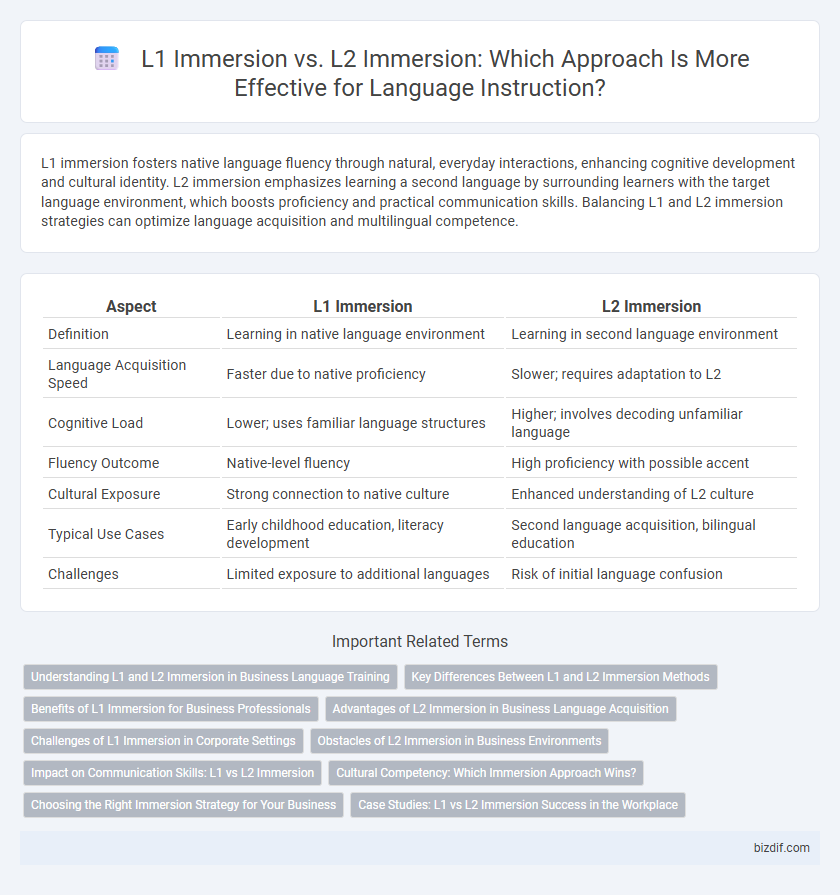L1 immersion fosters native language fluency through natural, everyday interactions, enhancing cognitive development and cultural identity. L2 immersion emphasizes learning a second language by surrounding learners with the target language environment, which boosts proficiency and practical communication skills. Balancing L1 and L2 immersion strategies can optimize language acquisition and multilingual competence.
Table of Comparison
| Aspect | L1 Immersion | L2 Immersion |
|---|---|---|
| Definition | Learning in native language environment | Learning in second language environment |
| Language Acquisition Speed | Faster due to native proficiency | Slower; requires adaptation to L2 |
| Cognitive Load | Lower; uses familiar language structures | Higher; involves decoding unfamiliar language |
| Fluency Outcome | Native-level fluency | High proficiency with possible accent |
| Cultural Exposure | Strong connection to native culture | Enhanced understanding of L2 culture |
| Typical Use Cases | Early childhood education, literacy development | Second language acquisition, bilingual education |
| Challenges | Limited exposure to additional languages | Risk of initial language confusion |
Understanding L1 and L2 Immersion in Business Language Training
L1 immersion in business language training leverages the learner's native language to build foundational understanding, facilitating quicker assimilation of complex business concepts. L2 immersion prioritizes direct engagement with the target language environment, enhancing practical communication skills and contextual fluency essential for real-world business interactions. Both approaches optimize language acquisition, but L2 immersion typically accelerates proficiency critical for global business operations.
Key Differences Between L1 and L2 Immersion Methods
L1 immersion involves teaching students primarily in their native language, reinforcing foundational literacy and cognitive skills before introducing a second language, whereas L2 immersion exposes learners directly to the target language to promote fluency and cultural competence. L1 immersion typically results in stronger comprehension and critical thinking in the first language, while L2 immersion accelerates second language acquisition through constant exposure and use. These methods differ in instructional focus, language transition timing, and outcomes in language proficiency and academic achievement.
Benefits of L1 Immersion for Business Professionals
L1 immersion for business professionals enhances cognitive efficiency by allowing deeper focus on complex concepts in their native language, facilitating clearer communication and decision-making. It supports the development of industry-specific terminology and nuanced language skills essential for client negotiations and leadership roles. Mastery of L1 through immersion also strengthens overall language confidence, leading to improved professional relationships and successful global collaborations.
Advantages of L2 Immersion in Business Language Acquisition
L2 immersion accelerates proficiency in a target business language by providing real-world communication contexts essential for mastering industry-specific terminology and cultural nuances. Exposure to authentic business scenarios during L2 immersion enhances negotiation skills, presentation fluency, and cross-cultural competence vital for global market success. Empirical studies demonstrate that L2 immersion learners outperform L1 immersion peers in practical business communication and adaptability within multinational corporations.
Challenges of L1 Immersion in Corporate Settings
L1 immersion in corporate language training often faces challenges such as limited exposure to the target language environment, leading to slower language acquisition compared to L2 immersion programs. Employees may struggle with vocabulary breadth and cultural nuances crucial for effective communication in international business. Furthermore, L1 immersion can reinforce native language structures that impede fluency in the second language, impacting overall language proficiency development.
Obstacles of L2 Immersion in Business Environments
L2 immersion in business environments presents significant communication barriers due to limited vocabulary and cultural nuances, impeding effective negotiation and collaboration. Employees may experience increased cognitive load and stress as they process complex information in a non-native language, reducing productivity. Moreover, differences in idiomatic expressions and business etiquette often lead to misunderstandings and decreased team cohesion.
Impact on Communication Skills: L1 vs L2 Immersion
L1 immersion enhances communication skills by fostering native language proficiency, which solidifies foundational linguistic structures and cultural nuances critical for effective expression. L2 immersion, while challenging, accelerates second language acquisition and promotes adaptability in diverse communication contexts, improving fluency and comprehension. Research indicates that balanced exposure to both L1 and L2 immersion cultivates superior bilingual communication skills, optimizing overall language development and cognitive flexibility.
Cultural Competency: Which Immersion Approach Wins?
L2 immersion enhances cultural competency more effectively than L1 immersion by exposing learners directly to the target language's cultural nuances and social norms. Experiencing real-world communication in an L2 immersion environment fosters deeper understanding and appreciation of diverse traditions, idioms, and customs. Research shows that students in L2 immersion programs develop stronger intercultural skills and greater global awareness compared to their L1 immersion counterparts.
Choosing the Right Immersion Strategy for Your Business
Selecting the appropriate immersion strategy for language instruction hinges on your business goals and target audience proficiency. L1 immersion leverages learners' native language to build foundational skills and ease comprehension, ideal for beginners or technical training. L2 immersion fosters quicker language acquisition and practical usage by immersing learners directly in the second language environment, suitable for advanced learners aiming for fluency and real-world application.
Case Studies: L1 vs L2 Immersion Success in the Workplace
Case studies reveal that L2 immersion programs enhance workplace communication skills and cultural adaptability more effectively than L1 immersion, resulting in higher employee performance and client engagement. Employees who undergo L2 immersion exhibit increased proficiency in target languages, leading to better collaboration in multinational teams and improved problem-solving in cross-cultural contexts. Organizations reporting success with L2 immersion highlight measurable gains such as reduced language barriers and elevated global market competitiveness.
L1 immersion vs L2 immersion Infographic

 bizdif.com
bizdif.com